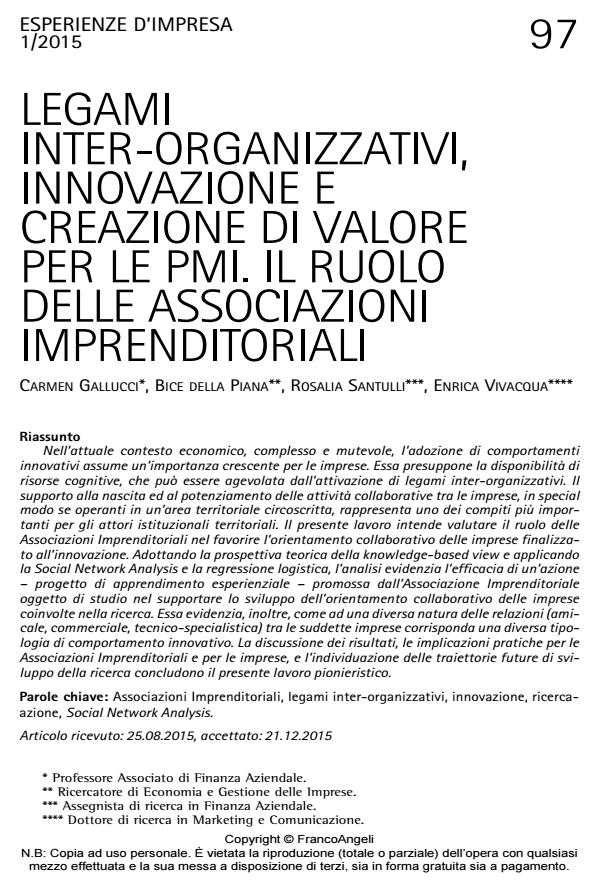Legami inter-organizzativi, innovazione e creazione di valore per le PMI. Il ruolo delle associazioni imprenditoriali
Titolo Rivista ESPERIENZE D'IMPRESA
Autori/Curatori Carmen Gallucci, Piana Bice Della, Rosalia Santulli, Enrica Vivacqua
Anno di pubblicazione 2016 Fascicolo 2015/1
Lingua Italiano Numero pagine 17 P. 97-113 Dimensione file 220 KB
DOI 10.3280/EI2015-001005
Il DOI è il codice a barre della proprietà intellettuale: per saperne di più
clicca qui
Qui sotto puoi vedere in anteprima la prima pagina di questo articolo.
Se questo articolo ti interessa, lo puoi acquistare (e scaricare in formato pdf) seguendo le facili indicazioni per acquistare il download credit. Acquista Download Credits per scaricare questo Articolo in formato PDF

FrancoAngeli è membro della Publishers International Linking Association, Inc (PILA)associazione indipendente e non profit per facilitare (attraverso i servizi tecnologici implementati da CrossRef.org) l’accesso degli studiosi ai contenuti digitali nelle pubblicazioni professionali e scientifiche
Nell’attuale contesto economico, complesso e mutevole, l’adozione di comportamenti innovativi assume un’importanza crescente per le imprese. Essa presuppone la disponibilità di risorse cognitive, che può essere agevolata dall’attivazione di legami inter-organizzativi. Il supporto alla nascita ed al potenziamento delle attività collaborative tra le imprese, in special modo se operanti in un’area territoriale circoscritta, rappresenta uno dei compiti più importanti per gli attori istituzionali territoriali. Il presente lavoro intende valutare il ruolo delle Associazioni Imprenditoriali nel favorire l’orientamento collaborativo delle imprese finalizzato all’innovazione. Adottando la prospettiva teorica della knowledge-based view e applicando la Social Network Analysis e la regressione logistica, l’analisi evidenzia l’efficacia di un’azione - progetto di apprendimento esperienziale - promossa dall’Associazione Imprenditoriale oggetto di studio nel supportare lo sviluppo dell’orientamento collaborativo delle imprese coinvolte nella ricerca. Essa evidenzia, inoltre, come ad una diversa natura delle relazioni (amicale, commerciale, tecnico-specialistica) tra le suddette imprese corrisponda una diversa tipologia di comportamento innovativo. La discussione dei risultati, le implicazioni pratiche per le Associazioni Imprenditoriali e per le imprese, e l’individuazione delle traiettorie future di sviluppo della ricerca concludono il presente lavoro pionieristico.
Parole chiave:Associazioni Imprenditoriali, legami inter-organizzativi, innovazione, ricercaazione, Social Network Analysis
Carmen Gallucci, Piana Bice Della, Rosalia Santulli, Enrica Vivacqua, Legami inter-organizzativi, innovazione e creazione di valore per le PMI. Il ruolo delle associazioni imprenditoriali in "ESPERIENZE D'IMPRESA" 1/2015, pp 97-113, DOI: 10.3280/EI2015-001005